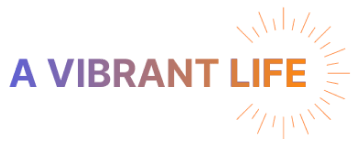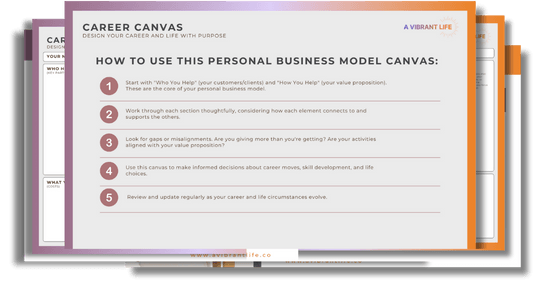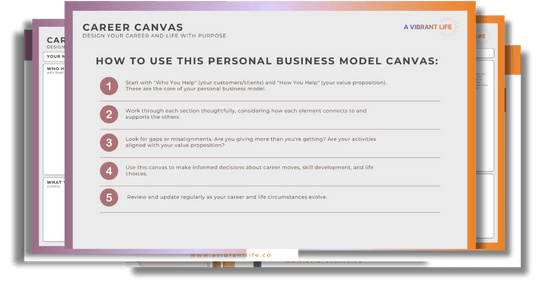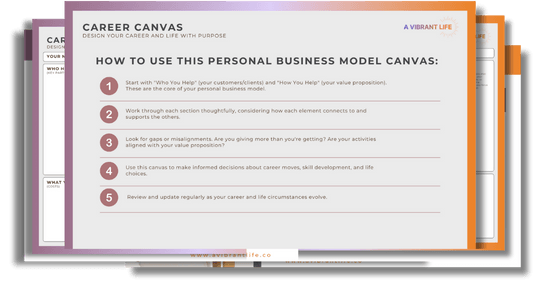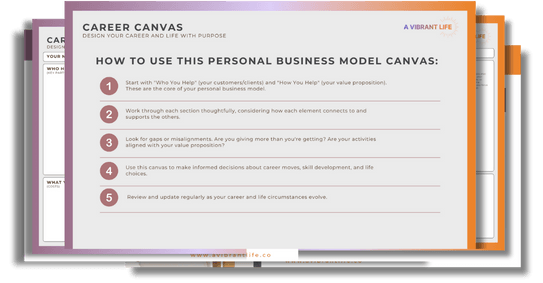Career Canvas: Strategic Career and Life Design | Vibrant Life
Most of us think about business models when it comes to companies and startups, but what if you applied the same strategic thinking to your own life and career? That's exactly what a career Canvas helps you do. It gives you a framework to understand how you create value, who you serve, and what you get in return.
Whether you're employed, freelancing, running your own business, or somewhere in between, thinking about yourself as a "business" can provide valuable insights into your career trajectory and life choices. It's not about being transactional or reducing relationships to mere exchanges. Instead, it's about being intentional with your time, energy, and talents.
What Is a Career Canvas?
A Career Canvas is a visual tool that maps out nine key elements of how you contribute to the world. Based on the traditional business model canvas, it helps you see the big picture of your professional purpose and identify areas for improvement or change.
The nine components work together to create a complete picture of your personal "business model":
The Value You Create
1. How You Help (Value Proposition): This is the core of everything—what value do you bring to others? What problems do you solve? What makes people better off because of your work? This might be helping companies make better decisions, teaching children to read, or creating beautiful spaces that inspire people.
2. Who You Help (Customer Segments): These are the people or organizations that benefit from your work. It could be your employer, clients, students, patients, or community members. Understanding exactly who depends on you helps you focus your efforts where they matter most.
3. Roles/Relationships (Customer Relationships): What kind of relationship do you have with the people you help? Are you an advisor, a problem-solver, a teacher, a caregiver? Understanding your role helps you show up more effectively.
How You Deliver Value
1. What You Do (Key Activities): These are the critical activities that make your value proposition possible. If you're a teacher, it might include lesson planning, classroom instruction, and student assessment. If you're a consultant, it could be research, analysis, and client presentations.
2. Who You Are/What You Have (Key Resources): This includes your skills, knowledge, experience, personality traits, and physical resources. What makes you uniquely qualified to do what you do? What assets do you bring to the table?
3. How They Know You/How You Deliver (Channels): How do people find out about you and your work? How do you deliver your value? This could be through your employer, networking, social media, or direct referrals.
Your Support System
Who Helps You (Key Partners): Nobody succeeds alone. Who supports your work? This might include colleagues, mentors, family members, professional networks, or service providers who help you do your job better.
The Exchange
1. What You Give (Cost Structure): What do you invest in to do your work? This includes obvious things like time and energy, but also opportunity costs—what you give up to pursue your current path. Consider both the "hard costs" (actual expenses) and "soft costs" (stress, missed opportunities, work-life balance trade-offs).
2. What You Get (Revenue Streams): What do you receive in return for your value? This includes salary and benefits, but also intangible rewards like personal satisfaction, learning opportunities, recognition, flexibility, or social impact.
Why Create Your Career Canvas?
Clarity About Your Value
Many people struggle to articulate what they're really good at or what unique value they bring. The canvas forces you to think clearly about your contributions and helps you communicate your worth more effectively—whether in job interviews, performance reviews, or when setting freelance rates.
Better Decision Making
When you can see your whole "business model" on one page, it becomes easier to evaluate opportunities. Does this new job align with your values and leverage your key resources? Will this side project complement or compete with your main activities? The canvas provides a framework for these decisions.
Identifying Imbalances
Sometimes we give more than we get, or we're not leveraging our best resources effectively. The canvas helps you spot these imbalances. Maybe you're spending too much time on activities that don't align with your core value proposition, or perhaps you're not being appropriately compensated for the value you create.
Strategic Career Planning
Instead of reacting to whatever opportunities come your way, you can be more strategic about building your career. The canvas helps you identify which skills to develop, which relationships to nurture, and which opportunities to pursue.Career Integration
Your career doesn't exist in isolation—it affects and is affected by other areas of your life. The canvas helps you see these connections and make choices that work for your whole Career, not just your professional goals.
The Career Canvas starts with defining your "contribution" — the specific problems you solve and value you create for others. It's a practical tool for designing your career like a business, mapping your customers, activities, and resources strategically. It looks at how you deliver value to identify what's working, what's missing, and what could be improved. Because it's called a canvas, it creates a complete picture of your professional purpose and path forward.
How to Create Your Career Canvas
The process is straightforward, though it requires honesty and some courage.
1. Start With Your Value Proposition
Begin with the most important question: How do you help others? What problems do you solve? What value do you create? Be specific about the benefits people receive from your work. Don't just say "I'm a good manager"—explain how your management style helps teams be more productive, creative, or satisfied.
2. Identify Your Customers
Who specifically benefits from your work? If you're employed, your "customers" include your employer, but also think about internal customers (other departments that depend on your work) and end customers (the people your company serves). If you're freelancing or running a business, this is more straightforward, but still worth thinking about deeply.
3. Map Your Resources and Activities
What do you actually do each day that creates value? Which of your skills, experiences, and personal qualities make this possible? Be honest about what energizes you versus what drains you—this information is valuable for future decisions.
4. Understand Your Support Network
Who helps you succeed? This includes obvious supporters like mentors and colleagues, but also consider less obvious ones like the barista who makes your morning coffee routine possible or the family members who handle responsibilities so you can focus on work.
5. Analyze the Exchange
What do you invest (time, energy, stress, opportunity costs) and what do you receive (money, satisfaction, learning, flexibility, impact)? Is this exchange sustainable and fair? Are there adjustments you could make to improve the balance?
6. Look for Connections and Gaps
Once you've filled in all nine sections, step back and look at the whole picture. Do your activities align with your value proposition? Are you leveraging your best resources? Is your support network adequate for your goals? Are there opportunities to optimize or areas that need attention?
Common Insights from the Canvas
The Overcommitted Helper
Many people discover they're trying to help too many different types of customers with too many different value propositions. This leads to scattered effort and burnout. The solution often involves focusing on your highest-impact contributions and saying no to requests outside your core value area.
The Undervalued Expert
Some people realize they're not being appropriately compensated for the value they create. This might mean negotiating for a raise, adjusting freelance rates, or seeking opportunities that better recognize their contributions.
The Misaligned Worker
Others discover that their daily activities don't actually support their stated value proposition. They might be spending too much time on administrative tasks when their real value comes from creative problem-solving or relationship building.
The Isolated Achiever
Sometimes the canvas reveals that someone is trying to succeed without adequate support. Building stronger partnerships and support networks can dramatically improve both effectiveness and satisfaction.
Using Your Canvas for Career Decisions
Career Changes
When considering a new job or career direction, use your canvas to evaluate the fit. Will this opportunity better leverage your key resources? Does it align with your preferred customer relationships? Will it provide a better balance of costs and benefits?
Skill Development
Instead of randomly collecting skills, focus on developing capabilities that strengthen your value proposition or expand your ability to serve your chosen customer segments.
Side Projects and Opportunities
Before taking on additional commitments, consider how they fit with your existing business model. Will they complement your main activities or compete with them for time and energy?
Life Stage Transitions
As your life circumstances change—new family responsibilities, health considerations, financial goals—you can adjust your personal business model accordingly. Maybe you need to prioritize flexible arrangements over high compensation, or perhaps it's time to leverage your experience in a more strategic role.
Keeping Your Canvas Current
Your personal business model isn't static. As you grow, learn, and face new circumstances, your canvas should evolve too. Consider reviewing and updating it every six months or during major Career transitions.
Pay attention to which elements are working well and which feel misaligned. Maybe your value proposition has evolved, or perhaps you've outgrown your current customer relationships. Regular updates help ensure your career stays aligned with your goals and values.
The Bigger Picture
Creating your Career Canvas isn't about turning yourself into a corporation or viewing every relationship as transactional. Instead, it's about being intentional with your most valuable resource, your time and energy, and making sure you're creating value in ways that align with your strengths and support your broader career goals.
When you're clear about your value, focused on the right customers, and strategic about your activities and relationships, work becomes more fulfilling and effective. You're not just busy, you're productive in ways that matter to both you and the people you serve.
The canvas also helps you communicate your value more clearly to others, whether that's in job interviews, performance discussions, or conversations with potential clients. When you can articulate not just what you do, but how it creates value and for whom, you become more memorable and valuable.
Most importantly, this exercise often reveals opportunities you hadn't considered. Maybe there's a way to leverage your skills in a new market, or perhaps you could restructure your work to better align with your values. The canvas provides a framework for these discoveries.
Take some time to map out your own Career Canvas. You might be surprised by what you discover about yourself and the opportunities available to you. Understanding your personal business model is the first step toward designing a career and life that truly works for you.
The Career Canvas starts with understanding your "value" — what unique contribution you make to the world and who benefits from it. It's a strategic framework for mapping how you create value, who you serve, and what you receive in return. It looks at your complete professional picture to identify your strengths, resources, and opportunities for growth.
Coaching Corner: Using the Career Canvas with Clients
For coaches, HR professionals, and consultants, the Career Canvas is a powerful tool for career development conversations. I typically use this with clients who are already running a business or actively exploring a potential career or business direction.
The canvas works best when clients can draw from previous self-discovery work. I have them refer back to their vision statement, All About Me document, and Johari Window insights as they work through each section. This approach helps connect their self-awareness and values to real-world career strategy.
Here's how to use it effectively in professional settings:
Session Setup and Flow
Plan for 90 minutes and send the blank template to clients beforehand for review (but don't have them complete it—you want to work through it together). Start with the core sections: "How You Help" and "Who You Help," as these provide the foundation for everything else.
Work through the canvas systematically, but spend extra time on sections that generate energy or resistance—these often reveal the most valuable insights.
Key Facilitation Questions
Rather than just filling in boxes, use these questions to dig deeper:
"What energizes you most about the value you create?"
"Who specifically depends on you to succeed in their own work?"
"What would happen if you stopped doing what you do?"
"Where do you see misalignment between what you give and what you get?"
"What sections feel hardest to define or fill out?"
When clients make broad statements like "I help everyone," challenge them to be specific. Help them identify patterns and connections between different sections.
Common Client Insights
The Overcommitted Helper: Trying to help too many different types of people with too many different value propositions. These clients need to focus and prioritize rather than being everything to everyone.
The Undervalued Expert: Not being appropriately compensated for the value they create. This often leads to conversations about negotiation, positioning, or career transitions.
The Misaligned Worker: Daily activities don't match their stated value proposition. They may need role clarity, boundary setting, or career pivots.
The Isolated Achiever: Lacks adequate support systems or partnerships. Help them identify potential collaborators and support networks.
Making It Actionable
The canvas is most valuable when it leads to concrete action. Help clients identify 1-2 priority areas for focus rather than trying to address everything at once. Transform insights into specific next steps: "I need better networking" becomes "Join the local marketing professionals group and attend their next monthly event."
Plan follow-up sessions to review progress and adjust the canvas as circumstances change. The tool works best as an ongoing conversation starter rather than a one-time exercise.
Professional Applications
Use this tool for career coaching sessions, HR development conversations, performance discussions, team development, and leadership coaching. It's particularly effective for career transitions, succession planning, and helping professionals understand their unique value proposition within their organization.

About Us
We are a community of practitioners & experts, passionate about empowering individuals & organizations with tools for growth, well-being, and transformation.
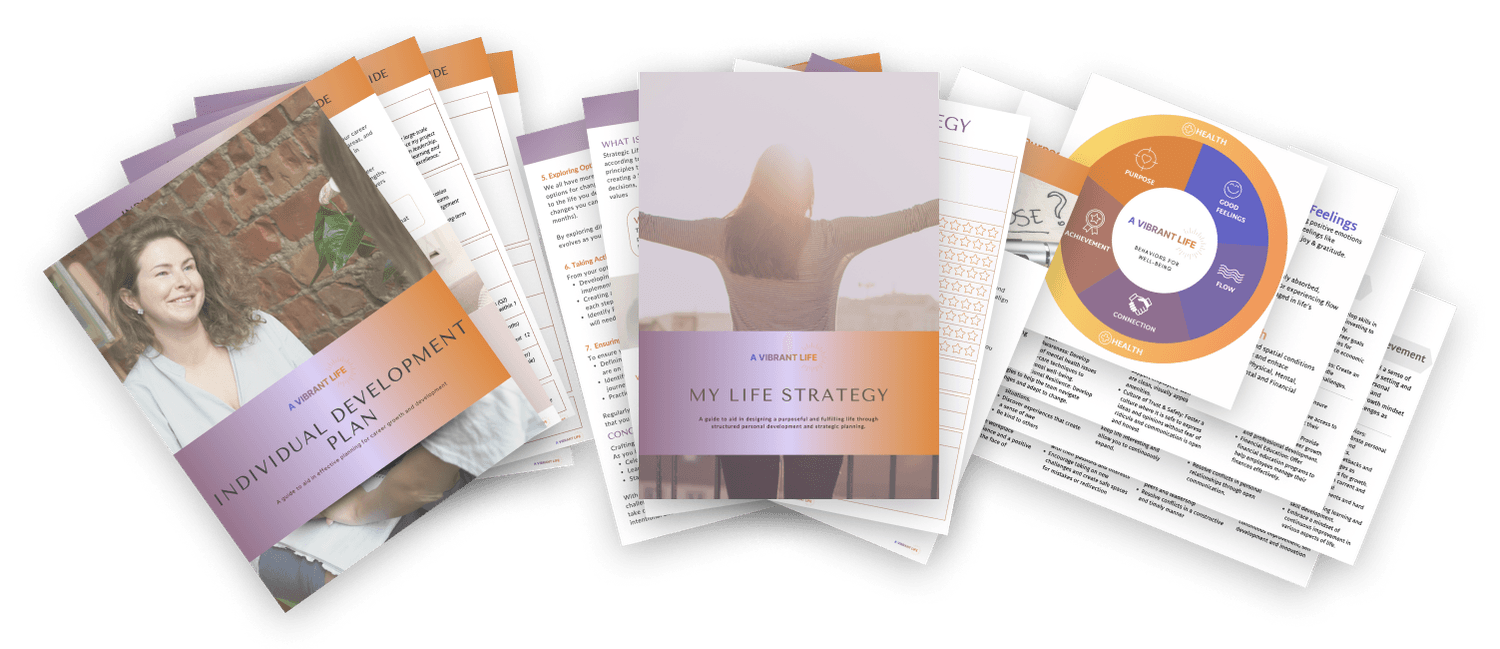
Explore Our Catalog of Transformative Products
Discover our range of expertly crafted products designed to help you achieve your goals and live a more vibrant life. Whether you're looking to advance your career, find balance, or create a thriving environment, our catalog has something for everyone.
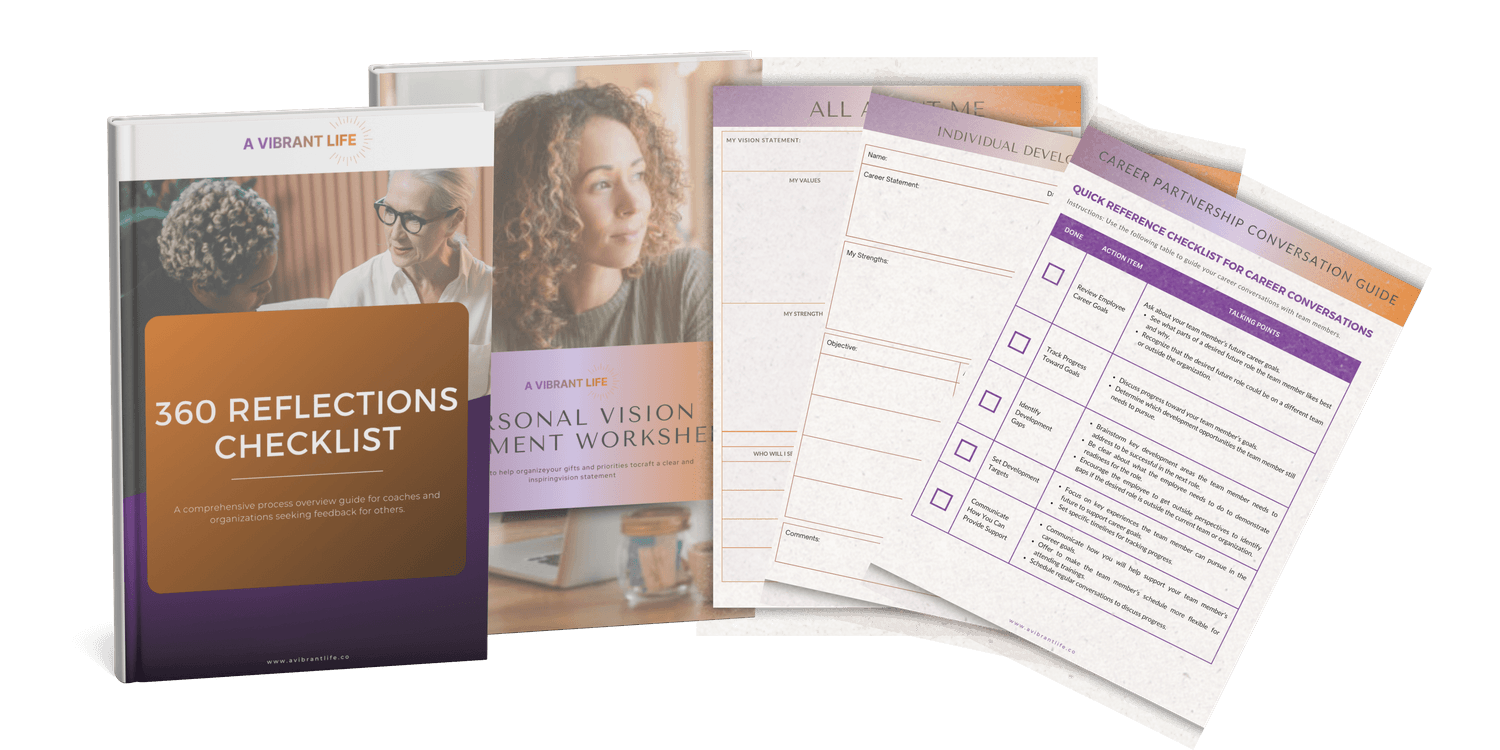
Discover Our Free Resources
Access our collection of valuable free tools, guides, and resources designed to support your personal growth journey. From starter templates to educational content, we're here to help you get started without any cost.
GET EXCLUSIVE ACCESS
Collaborate and Grow with Our HR and Coaching Community
Get exclusive content and resources designed to help you thrive both personally and professionally. Become a member of the A Vibrant Life community and gain access to expert insights, practical strategies, and a supportive network of like-minded individuals.
Your privacy is important to us. We promise to keep your email safe and never spam.

Ready to take the next step towards a vibrant life and fulfilling career?
Explore our transformative solutions tailored to meet you where you are and guide you to where you want to be.
